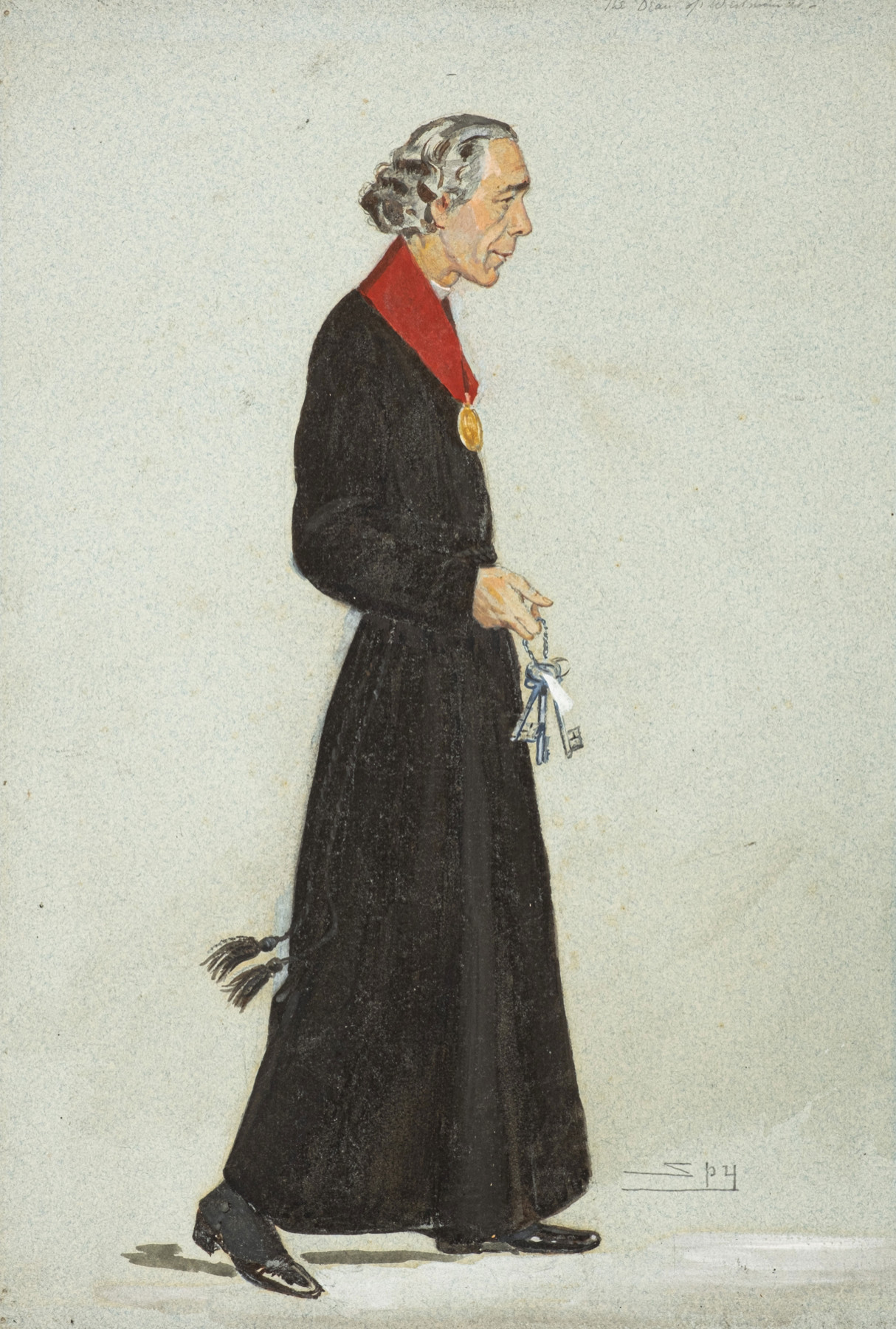
(click image to enlarge)
Joseph Armitage Robinson (1858-1933) was one of the leading Anglican clerics and theological scholars of the late nineteenth and early twentieth centuries. He was educated at Cambridge, and, as a fellow of Christ’s College, taught and researched, while also taking up various positions, including that of domestic chaplain to J B Lightfoot, the Bishop of Durham and probably the leading European scholar of patristics (1883-84). His positions at Cambridge included Dean of Christ’s College (1884-90) and Norrisian Professor of Divinity (1893-99). In 1891, he became editor of the first of a new series of Cambridge ‘Texts and Studies’, and was a key contributor to later numbers. As early as 1894, his impact on international scholarship was marked by honorary degrees from Göttingen and Halle universities.
In 1899, Robinson moved to London to become Rector of St Margaret’s Westminster (1899-1900) and then Dean of Westminster (1902-11), the role in which Spy here presents him. The cathedral chapter sometimes considered his actions autocratic, and so it sought, unsuccessfully, to limit his powers. While at Westminster, he continued to publish, and distinguished himself as both a theologian and a historian. Especially important was his landmark commentary of St Paul’s Epistle to the Ephesians (1908).
In 1911, Robinson became Dean of Wells, in Somerset (which was already familiar to him as he had held the prebend of Compton Bishop during the late 1890s). Wells Cathedral stimulated his antiquarian interests, and the county of Somerset inspired further publications. During the 1920s, he became an active participant in the five Malines Conversations, which explored the possibilities of reunion between the Roman Catholic Church and the Church of England.
“Dr. J. Armitage Robinson was born at Keynsham Vicarage, in Somerset, on January 9, 1858, being the third son of the Rev. George Robinson, who, removing to Liverpool later on, took his place as one of the leading evangelical clergymen in that city. His son, Armitage, went up from Liverpool College to Christ's College, Cambridge, where in 1881 he took a distinguished degree as fourth classic and winner of one of the Chancellor's Medals. He was elected Fellow of his College; but served his apprenticeship in Holy Orders as domestic chaplain to Bishop Lightfoot.
Recalled from Bishop Auckland to Cambridge in 1884, in order to become Dean of his College, he threw himself into the life of the University, where he spent the next fifteen years, for the last six of which he occupied the chair of the Norrisian Professor of Divinity. While thus engaged, he acquired a European reputation for his knowledge of early Christian literature. He also started and edited the Cambridge series of ‘Texts and Studies’, he himself publishing various works, the very titles of which show that they are caviare to the multitude. This devotion to study was balanced by preaching and other essays in practical divinity. He was for four years Vicar of All Saints', Cambridge; so that his appointment by Lord Salisbury in 1899 to a Canonry at Westminster with the Rectory of St. Margaret's was recognised as a fitting sequel to his career at Cambridge.
Three years later King Edward VII acceded to the Throne, and then it was found that in the Chapter of the Collegiate Church of St. Peter's, Westminster, Dr. Robinson was the one who had thoroughly mastered the ritual and traditions of the Coronation Service. Accordingly, when Dean Bradley had resigned at the following Michaelmas, it caused no surprise to hear that the King had nominated Dr. Robinson as his successor. Deans of Westminster have in times past generally been numbered among the octogenarians, and to appoint a Dean at the comparatively youthful age of forty-four was a rather unusual experiment. It has been justified.
Dr. Robinson's learning and scholarship befit a decanal stall; his appreciation of the history of the past with his sound artistic taste make him a trustworthy guardian of the most beautiful and famous of our national sanctuaries; while the dignity of his presence, enhanced by the ribbon of the Bath, lends an ornament to its services.
In appearance he is a thorough ecclesiastic, of a type which reminds me of the Church dignitaries of the early sixteenth century. A good raconteur, and possessed of a wit which is at times almost caustic, but always good-natured, he is an acquisition to the dinner table when he will dine out - for he has to some extent the student's tendency to become a recluse.
In ecclesiastical politics, the Dean of Westminster is hard to label. Born and bred in a strict evangelical family, broadened by critical studies at the University, with a natural inclination for ritual, and made a High Churchman by a deep realisation of the meaning of ‘the Church’, Dr. Robinson has sympathies with all the Church parties, and strenuously holds aloof from party warfare. His preaching, which is evangelic and simple, though scholarly, draws large congregations; and his Advent lectures, in which he applies his remarkable powers of lucid exposition to the unravelling of modern difficulties, have become a feature of the Abbey's yearly course. The Deanery reflects the character of the Dean. There is no Mrs. Robinson; and the place of a family is taken by a few young graduates, studying theology. A severe simplicity in its decorations, characterised by excellent taste, serves to keep the ancient ‘Place’ of the Abbots of Westminster in due harmony with their Church of Westminster and the considerable remains of its monastic surroundings.”